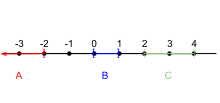
In mathematics, and more specifically in general topology, compactness is a property that generalizes the notion of a subset of Euclidean space being closed (that is, containing all its limit points) and bounded (that is, having all its points lie within some fixed distance of each other). Examples include a closed interval, a rectangle, or a finite set of points. This notion is defined for more general topological spaces than Euclidean space in various ways.
One such generalization is that a space is sequentially compact if any infinite sequence of points sampled from the space must frequently...